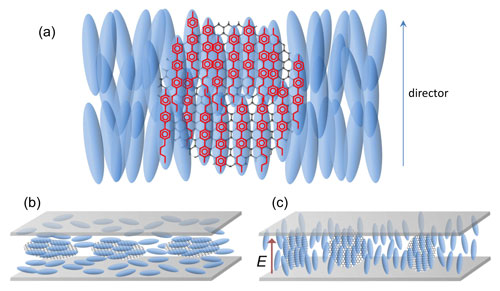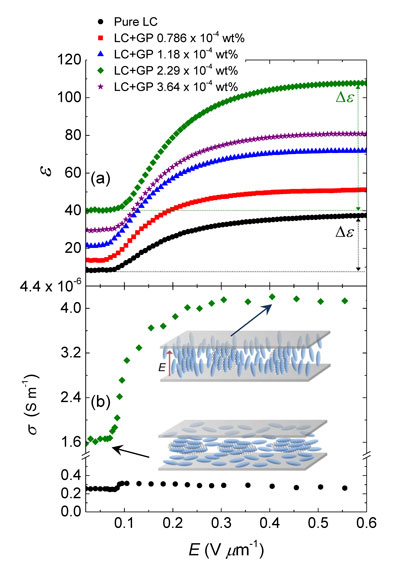| Posted: May 25, 2015 | |
Nano-electromechanical rotation of graphene in a liquid crystal platform |
|
| (Nanowerk Spotlight) Graphene acts as an excellent conductor to electric fields along its flat surface and as an insulator perpendicular to the surface. Due to this anisotropic nature of graphene's conductivity, graphene flakes have potential applications in nanoscale switches and nano-electromechanical systems (NEMS). Controlling the orientation of graphene flakes therefore has drawn a great deal of research interest in nanotechnology. | |
| In new work, researchers at the United States Naval Academy have developed a technique to control the orientation of graphene flakes at the nanoscale by using a nematic liquid crystal (LC) platform (in the nematic LC phase the molecules are oriented in parallel but not arranged in well-defined planes). | |
| "The multifaceted interactions between nematic liquid crystals and various nanomaterials have been an active area of fundamental and applied research over the past decade," Rajratan Basu, an Assistant Professor in the Department of Physics at the United States Naval Academy, tells Nanowerk (see for instance our previous Nanowerk Spotlight "Cleansing the ionic impurities in LCDs with nanoparticles"). "Especially the two-dimensional honeycomb structure of graphene shows very interesting interactions with an LC." | |
| Reporting their findings in the May 22, 2015 online edition of Applied Physics Letters ("Nano-electromechanical rotation of graphene and giant enhancement of dielectric anisotropy in a liquid crystal"), Basu and his students Midshipman Daniel Kinnamon and Midshipman Alfred Garvey have demonstrated that in the presence of monolayer graphene flakes the nematic LC exhibits a giant enhancement of dielectric anisotropy. | |
| The nematic phase of an LC has a long range orientational order of the LC molecules, and the average orientational direction is called the nematic director. This director can be oriented along a particular direction by applying an external electric field. | |
| "When a small quantity (∼10-4 wt%) of graphene flakes is doped in a nematic LC, the flat surface of the graphene aligns parallel to the nematic director due to the π-π stacking between the LC's benzene rings and the graphene's honeycomb structure," Basu explains. "The LC-graphene polar surface anchoring energy is minimized when the graphene flake aligns its flat surface parallel to the far-field nematic director." | |
 |
|
| Figure 1: Schematic illustrations of graphene-LC interactions: (a) Alignment of graphene in a nematic LC due to π-π electron stacking. Blue ellipsoids are liquid crystals and the black honeycomb structure is a graphene surface. A generic molecular structure of a liquid crystal is shown in red in each ellipsoid on the graphene surface. The π-π electron stacking is illustrated by matching the LC’s benzene rings on the graphene-honeycomb structure. (b) Orientation of the LC + graphene hybrid in a cell when the electric is off. (c) Orientation of the LC + graphene hybrid in a cell when the electricity is on. (Image: Dr. Basu, United States Naval Academy) | |
| Figure 1 (a) above schematically shows the π-π stacking and the graphene's alignment along the director of the LC. | |
| In a uniform homogeneously aligned parallel-plate LC cell configuration, the director is initially aligned perpendicular to the external field due to the LC-substrate surface anchoring mechanism. When the field is above a critical threshold, the director reorients parallel to the field, obtaining a homeotropic configuration. | |
| "As graphene flakes are coupled to the nematic director in a graphene-doped LC, the flakes also follow the electric field driven director rotation inside the cell," Basu notes. Figures 1 (b) and (c) schematically show the rotation of graphene flakes in an LC cell. | |
| Basu, Kinnamon, and Garvey observed a huge increase in conductivity and a giant enhancement in dielectric anisotropy, shown in Figure 2 below. These results coherently manifest the orientational coupling of the graphene surface to the LC director and their nano-electromechanical rotation in the LC cell. | |
 |
|
| Figure 2: (a) Dielectric constant ε as a function of applied field in the nematic phase for the pure LC and LC + graphene (GP) hybrids listed in the legend. (b) Electrical conductance σ as a function of applied field in the nematic phase for the pure LC and LC + GP, listed in the legend. The reorientation of the graphene flakes with the nematic director is shown in the inset schematics. (Image: Dr. Basu, United States Naval Academy) | |
| The researchers point out that these results are important for developing novel NEMS and nanoscale actuators, employing the graphene flakes' mechanical rotation at the nanoscale via a nematic platform driven by electric fields. | |
| This work was supported by the Office of Naval Research (Division 312: Electronics Sensors and Network Research) under Award No. N0001414WX20791. | |
 By
Michael
Berger
– Michael is author of three books by the Royal Society of Chemistry:
Nano-Society: Pushing the Boundaries of Technology,
Nanotechnology: The Future is Tiny, and
Nanoengineering: The Skills and Tools Making Technology Invisible
Copyright ©
Nanowerk LLC
By
Michael
Berger
– Michael is author of three books by the Royal Society of Chemistry:
Nano-Society: Pushing the Boundaries of Technology,
Nanotechnology: The Future is Tiny, and
Nanoengineering: The Skills and Tools Making Technology Invisible
Copyright ©
Nanowerk LLC
|
|
|
Become a Spotlight guest author! Join our large and growing group of guest contributors. Have you just published a scientific paper or have other exciting developments to share with the nanotechnology community? Here is how to publish on nanowerk.com. |
|
